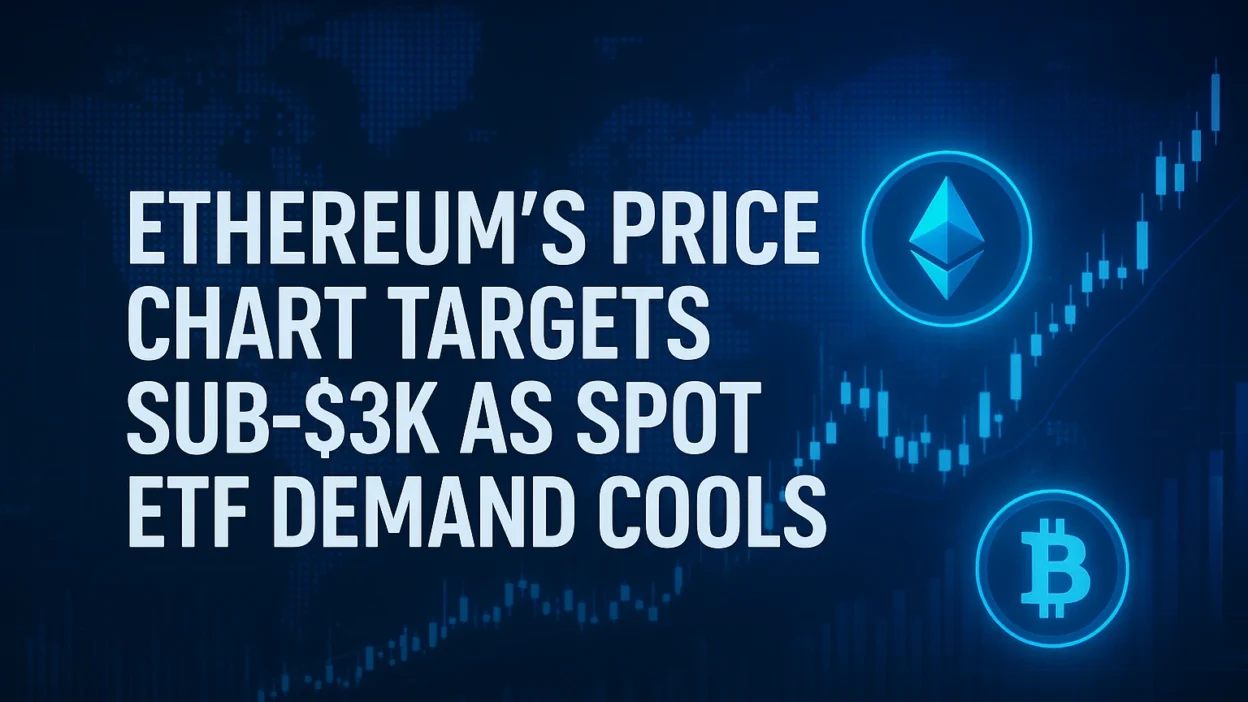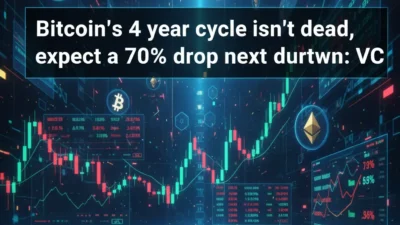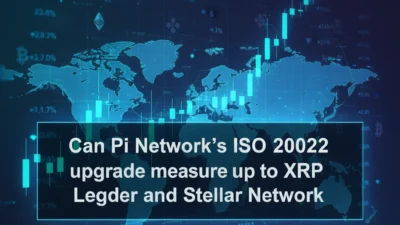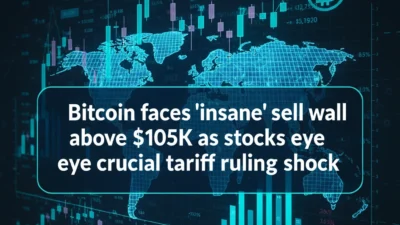Introduction
Ethereum’s price momentum has lost steam in recent sessions as fresh data show institutional appetite for spot ETH via exchange-traded funds moderating. That slowdown in ETF demand has coincided with fading fund inflows and occasional outflows, creating a plausible pathway for ETH to test sub-$3,000 support — analysts and chartists now cite $2,800 as a short-term downside target if selling intensifies. This post breaks down the drivers, charts the most likely scenarios, and offers practical guidance for traders and investors navigating this environment. cedirates.com
Why ETF demand flows matter for Ethereum price
Spot ETFs convert institutional capital into a product that buys and holds real ETH in custody. When ETF inflows surge, custodians buy spot ETH to back shares, shrinking available sellable supply and exerting upward pressure on price. Conversely, when flows slow or reverse, that mechanical buyer can weaken — leaving price more exposed to natural selling and macro shocks.
Recent daily and weekly ETF metrics show a clear cooling phase: days with net inflows have become less frequent and some products recorded outflows, signaling that the direct institutional faucet is no longer as reliably supportive as it was during earlier phases of the rally. That change in ETF demand has become a dominant theme in traders’ risk models. coinglass
What the data says right now
Multiple data providers tracking ETF flows and AUM report that the torrid inflows seen earlier this year have slowed. CoinGlass and other aggregators show days of net redemptions alongside smaller inflow figures, suggesting the marginal buyer (institutions buying via ETFs) is less active. News outlets have highlighted episodes of meaningful outflows from ETH ETF products, which corresponded to short-term price weakness. coinglass
At the same time, some large institutions that bought earlier — including well-known asset managers — still hold significant ETH allocations on behalf of clients. But the directional clarity that sustained the rally has waned: in short, ETF demand is still material, but its intensity and reliability have decreased. Sygnum Bank
Technical picture — why $2,800 is on the radar
From a technical standpoint, the recent price action shows exhaustion around recent highs and a loss of upward momentum. Key shorter moving averages have flattened and volume during rallies has been lower than during prior surges. These classic divergence signals increase the probability of a pullback.
Chartists point to a cluster of supports between roughly $2,700–$3,000 (depending on which moving averages and Fibonacci retracements are used). If sellers intensify and ETF-driven buying remains muted, the path to the $2,800 area becomes statistically more likely. A failure to hold $2,800 could open the door to deeper tests around the next major support band near $2,200–$2,400, especially if macro conditions worsen. Cryptonews
Macro and sentiment drivers
Beyond ETF flows, several macro and sentiment factors matter:
- Risk-on vs. risk-off: A shift toward risk aversion (stronger dollar, rising bond yields, equity weakness) reduces appetite for digital assets.
- Derivatives & leverage: High open interest and crowded long positioning can accelerate down moves via forced liquidations when sentiment flips.
- On-chain selling: If large holders or newly created treasuries decide to rebalance, on-chain supply to exchanges can pressure price.
- Competition with Bitcoin: At times institutional capital rotates between Bitcoin and Ethereum; if BTC reclaims the spotlight, ETF demand for ETH can cool further.
A modest Fed or macro scare could therefore amplify the technical story and increase the odds of a short-term correction toward the $2,800 reference point. Reuters
Institutional narrative — cooling but not gone

It’s important to emphasize nuance: while ETF demand has cooled, that does not mean institutions have abandoned Ethereum. Several banks and asset managers continue to forecast strong long-term fundamentals for ETH (staking yields, DeFi utility, and token scarcity pressures from ETF custody). Big banks published bullish multi-scenario forecasts just months ago, while noting ETF flows could be lumpy and episodic. In short, long-term institutional conviction remains, but the immediate mechanical buyer effect from ETFs has become more variable. Reuters
On-chain signals to monitor
If you want to anticipate whether the dip will hold or deepen, follow these on-chain and flow indicators:
- ETF demand inflow/outflow dashboards: Daily and cumulative flows from major ETF providers. Sudden outflows increase downside risk. coinglass
- Exchange net flows: Large net transfers of ETH to exchanges suggest selling pressure.
- Whale accumulation: Accumulation by wallets holding large ETH balances can be a stabilizing signal.
- Staking flows: Changes in staking deposits/withdrawals alter available liquid supply.
- Derivatives open interest & funding: Sharp drops in open interest can indicate deleveraging; rising funding costs often precede volatility.
Combining these signals with price action provides the best early warning for a move toward $2,800 or below.
Scenario analysis — three paths forward
1. Bearish — ETF demand flows weaken further, price tests $2,800
If ETF demand continues to slow and macro risk intensifies (dovish central-bank surprises interpreted as economic weakness), ETH could slip to and test the $2,800 level. Liquidations could accelerate the decline, especially with elevated leverage in derivatives markets.
2. Neutral — cushioned dip and stabilization
ETF flows may wobble but not reverse materially; on-chain accumulation by long-term holders and reduced leverage could stabilize price in the $3,000–$3,800 range. This would be consistent with healthy consolidation after a strong prior run.
3. Bullish — renewed ETF inflows and rotation back to ETH
A renewed wave of institutional buying — triggered by favorable regulatory news, token-use growth, or renewed ETF marketing into accounts — could restore ETF demand and fuel a return above the previous highs. In this case, $2,800 would be a short-lived scare and a buy-the-dip opportunity for longer-term investors. Sygnum Bank
Trading and risk management playbook
If you’re an active trader or investor, consider these practical steps:
- Define risk bands: Set clear support and resistance levels (e.g., $2,800 key short-term support).
- Reduce leverage: When ETF flows are uncertain, leverage amplifies losses. Lower leverage until flows and on-chain selling stabilize.
- Stagger entries: For investors wanting exposure, phase buys across $3,200 → $2,900 → $2,600 to avoid catching a falling knife.
- Use options for protection: Put spreads or collars can cap downside while allowing upside participation.
- Follow ETF flow dashboards daily: Quick changes in ETF demand can materially shift price dynamics within 24–48 hours. coinglass
Why long-term bulls still have arguments
Despite the immediate risk to price, structural arguments for Ethereum persist:
- Staking economics: ETH has utility for staking, offering yield that attracts institutional treasuries.
- DeFi and tokenization: Continued growth of DeFi and tokenized assets increases transactional demand.
- Network upgrades and scaling: Layer-2 adoption and protocol improvements can increase throughput and fee capture.
- Institutional holdings: Many institutions view ETH as a strategic holding for exposure to blockchains and smart contract platforms.
These themes mean that a temporary retracement driven by cooling ETF demand might create accumulation opportunities for patient, conviction-driven investors. Reuters
What could make this bearish thesis accelerate?
Several catalysts could push ETH decisively toward $2,800 or lower:
- Sustained spot ETF outflows. Continued redemptions remove a predictable buyer and can flip neutral supply/demand dynamics into net selling. Evidence of multi-week ETF withdrawals is the clearest immediate risk. TradingView
- Macro repricing. If risk appetite collapses or the dollar rallies strongly on macro surprises, capital that funded speculative positions could rotate out of crypto — compounding ETF weakness. Investopedia
- Liquidation cascade. A shallow breakdown can trigger derivatives liquidations that amplify selling, especially in a market where some traders still run substantial leverage.
- Acceleration of token selldowns from corporate treasuries. If corporate treasury moves or large wallets decide to rebalance by selling ETH, that increases supply pressure when demand is already cooling. TradingView
Any one of these — or a combination — could accelerate the move to test the $2,800 demand zone.
Monitoring checklist (what to watch in the next 72 hours)
- Total daily net ETF flows (direction and magnitude). coinglass
- Exchange inflows/outflows and large wallet transfers.
- Funding rates and open interest across major derivatives venues.
- Macro data releases (inflation, employment) that could shift risk appetite.
- News on staking policy, regulatory updates, or ETF product adjustments.
If ETF flow metrics flip back to sizable net inflows, the downside scenario loses probability quickly. Conversely, sustained outflows make the $2,800 downside scenario more likely.
The evidence: flows, reserves and price structure
Three pieces of observable evidence point to elevated downside risk:
- ETF demand outflows — Multiple sources reported weeks where spot Ether ETFs posted net outflows rather than inflows, reversing the earlier trend of steady accumulation by institutions. Outflows were recorded across major products, led by headline names. This data signals that at least part of the institutional bid has paused. TradingView
- Strategic reserves drawdown — Analytic trackers show ETF and treasury reserves of ETH fell by a sizeable number of tokens since mid-October, meaning holders either sold or reallocated — removing a layer of structural demand that had been supportive. CoinTelegraph/TradingView summary pieces captured this dynamic in the recent move lower. TradingView
- Technical structure — descending patterns — On multiple timeframes, ETH’s chart shows lower highs and a descending triangle/declining trendline. Technical analysts point to objective price targets in the low-$2,800 area should the horizontal support level fail to hold. Combined with weaker ETF flows, this technical setup becomes more vulnerable to downside acceleration. TradingView
Together, these three signals create a higher-probability path to a sub-$3K test if selling pressure continues.
Conclusion
Ethereum’s short-term trajectory now hangs in part on the stability of institutional buying via ETFs. The mechanical buyer effect that once compressed supply and forced higher prices has cooled — and until ETF demand re-accelerates, ETH looks vulnerable to a meaningful correction toward the $2,800 area. That outcome is not inevitable, but it is plausible, and traders should map their risk accordingly.
At the same time, long-term fundamentals and institutional interest still offer compelling reasons for conviction buyers to prepare for accumulation opportunities if price actions create favorable entries. In short: manage risk, follow ETF flows closely, and let the data — not the headlines — guide your decisions. coinglass
Disclaimer
This article is for informational purposes only and does not constitute financial, investment, or trading advice. Cryptocurrency markets are highly volatile and carry substantial risk of loss. Always do your own research and consult a licensed financial advisor before making investment decisions. Do at your own risk.
Author review
Author: Ali hamza




